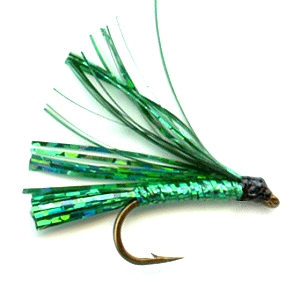Green Sparkler
The tinsel used in dressing the Sparkler wet fly pattern reflects any available sunlight and attracts the attention of nearby trout and grayling. This attractor pattern looks like a young darting bait fish.

SPARKLER HOLOGRAPHIC TINSEL STREAMER FLY PATTERNS. Hook size 10 12 14 - $US each
I like fly fishing in a boat, on the reservoir in the Autumn. The surface water has cooled down and the rainbow and brown trout are active. At this time of the year they have to put on weight if they are to survive the winter so they concentrate on food with a high calorie content, and that means fry feeding
If you have experienced a hit summer there should be an explosion of fry numbers on any still water. Once the trout get a taste for them they are zeroed in to this one food source. When on the water let nature help you pin point where trout are surface feeding on fry. Look for screaming sea gulls attacking the water. Go and investigate that area. Try a washing line rig with a difference. Tie on a booby nymph to the point fly as normal, but instead of tying on epoxy buzzers, gold ribbed hare’s ears or pheasant tails, tie on some streamers as droppers. A pink and silver, blue and silver, silver and green and silver sparkler have worked well for me in these situations. If you look at the natural juvenile fish that inhabit large still waters you will notice that the all have white or near silver undersides with a darker coloured back. The trout nearly always look upwards for food and are trying to spot the silver light stomach of an unsuspecting fry. This is why the sparkler fly pattern is so successful because it mimics the look of the natural when viewed from below.
The booby nymph on point keeps the leader buoyant and horizontal which allows droppers to swim more naturally in the water. Do not be tempted to pull the booby. Resist the temptation. These flies work best when fished static in the current. Just case out and let the current do the work. This results in a much more natural presentation. On more choppy water I might use a hopper, foam beetle or Goddard’s Caddis as the top fly. Just cast out 15 to 20 yards and keep in touch with the flies by making sure you do not have a slack line. You have to concentrate all the time because the trout can appear from nowhere very suddenly. You are tempting fate if you rest your rod to take a bite of a sandwich. You know that will be the time when a monster trout’s mouth will envelope one of your flies and speed off to the depths where it feels safer.
If there are no helpful flocks of seagulls around look for places that offer protection to shoals of fry. Work out where the water’s feeder streams are and spot the clumps of vegetation that like to grow in these locations. They offer ideal temporary shelter. Planted banks of yellow flowering flag iris also offer the same type of protection to young fish and are great starting points.
Fly Fishing books

